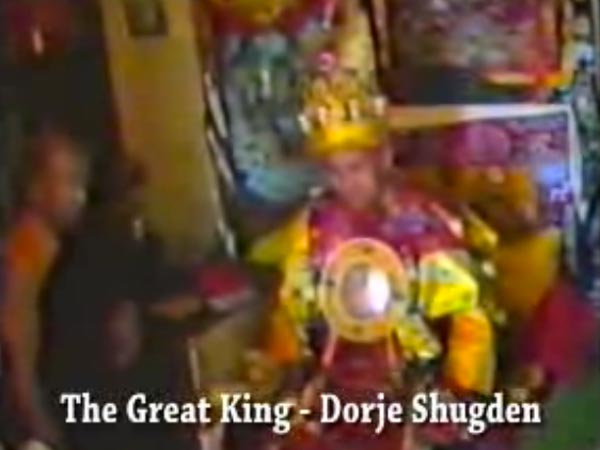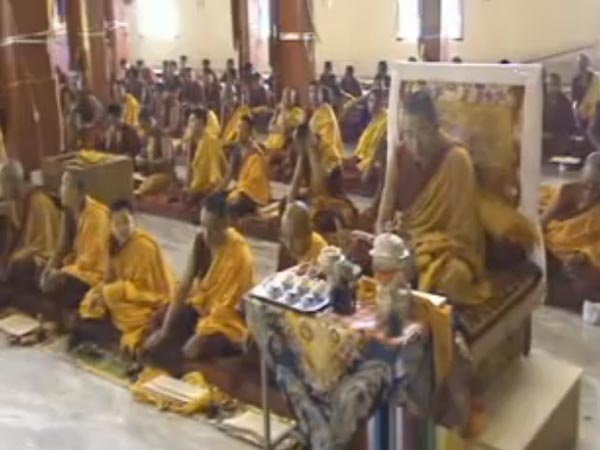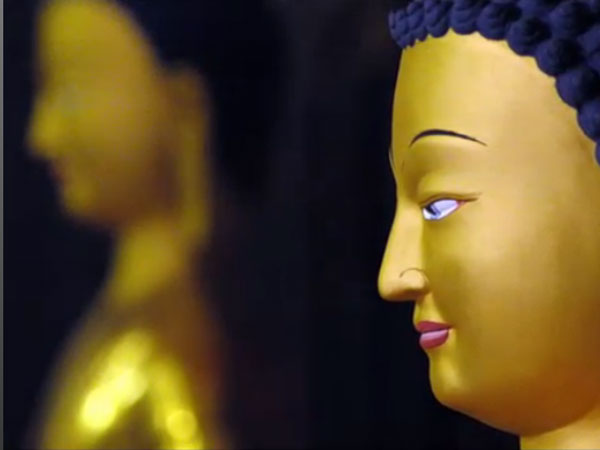DHARMA READINGS
| OFFERINGS - MANDALA OFFERING, TSOK OFFERING... | | Print | |
Page 3 of 3
 Mandala offering The physical base for making a mandala offering can be round or square, made of precious or ordinary materials, depending on what is available to the individual. When the mandala is offered formally in a wealthy monastery, the base may be made of gold or silver, but a solitary hermit might use simply a slab of stone or a flat piece of wood. Whatever it is made of, the base should be kept very clean and washed with saffron scented water. The material which is heaped onto the base to represent the various constituent offerings can be jewels, shells, clean grain or crushed white stone. Rice is commonly used. After sprinkling a little rice over the smooth base, the practitioner wipes his or her forearm over the mandala base in a circular motion. The arms movement away symbolizes clearing away all impurities in the world and all defilements in the mental continuums of sentient beings. The arms movement towards himself or herself symbolizes bringing forth everything positive and virtuous in the world. All worlds are then visualized as having becoming like pure lands, pristine and of the essence of jewels. All beings dwelling in them have become like deities, freed from suffering. Merely imagining that all beings are free from disturbing emotions and afflictions does not actually set them free. But by imagining that others have been purified, appreciating the value of purification provides the impetus for purifying your own mind. The surface of the mandala is once again evenly spread with grain. While doing this we imagine spreading jewels and flowers over the surface of the whole world. Grain is then scattered in a circular pattern around the edge of the mandala, symbolizing the iron fence described in Buddhist cosmology as encircling the four continents and the eight subcontinents. A handful of grain, symbolizing Mount Meru, is placed in the centre. Half of Mount Meru is below the sea. The half above the surface of the sea has four levels, topmost of which is Indra's mansion and heavenly abode. The three lower levels are the abodes of the other gods. The eastern face of Mount Meru is white and of the nature of crystal. The southern face is blue and made of sapphire. The western face is red and made of rubies and the northern face is yellow and made of gold. Around Mount Meru are seven gold mountains. The oceans surrounding them are inhabited by inestimably wealthy nagas. The eastern continent, which faces the object to whom the offering is being made, is white and crescent-shaped. The southern continent is blue and triangular, the western continent is red and circular, and the northern continent is yellow and square. Each continent is flanked on either side by a smaller subcontinent. The inhabitants of the continents are imagined to be attractive and wealthy. Representing the eastern continent, which is visualized as a mountain of jewels, a small heap of grain is made in the direction facing the Lama. Another heap represents the southern continent, which is visualized as a wish-fulfilling tree. On the western continent is an abundance of cows and milk and on the northern continent, uncultivated harvest of outstanding nutritional value. Small heaps of grain are made to represent the seven emblems of a universal monarch. Between the eastern continent and Mount Meru, another heap of grain represents the precious wheel; between the southern continent and Mount Meru, another heap of grain represents the precious jewel; between the western continent and Mount Meru is the precious queen; and between the northern continent and Mount Meru is the precious minister. Between the south and east continents is the precious elephant; between the south and west, the precious horse; between the west and north, the precious general; and between the north and east, a vase of jewels. The precious general can sometimes be a precious chamberlain, but in the present era, which is considered to be a degenerate time, a precious general is thought to be more useful in expelling evil forces and obstacles. The eight offering goddesses are very beautiful. They sing, dance, and carry garlands, flowers and incense over all four continents. The sun, which symbolizes the wisdom understanding emptiness, has the power to clear way all disturbing emotions, is represented by a heap of grain in the east. The moon, which stands for great compassion, is represented in the west. On the right, a small heap of rice represents a bejewelled umbrella of the kind the King of the Nagas offered the Buddha. It is gold with a sapphire handle and its edges are studded with jewels, including diamonds which shine like the sun. The jewels give off a nectar which can quench the thirst of all sentient beings and is suitable for offering an ablution to the Buddha. Attached to the umbrella are bells whose melodious sound conveys the doctrine to sentient beings according to their capacities. On the left is a victory banner bearing symbols of united opposites such as the lion-garuda, the otter-fish and the sea-monster conch. These symbolize overcoming disturbing emotions and are said to bring prosperity. This banner is an auspicious sign for saving all beings from the heat of cyclic existence. Another handful of grain scattered all around the base symbolizes the entire wealth of the world. Since an empty world is meaningless, it is imagined populated by countless beings, free from disturbing emotions and suffering and enjoying the abundance already described. The practitioner imagines a splendid mansion as a residence for the Lama, within which is a throne supported by lifelike lions. He or she imagines a multitude of worthy disciples, himself or herself foremost among them, which is regarded as creating an auspicious cause for becoming the Lama's principal disciple in future. Attaining such status, he or she can understand and accomplish the Lama's wishes for the purpose of sentient beings. As the meditator makes this offering to the Lama or to his visualized image, he or she imagines a replica of the Lama emanating from the original and descending into the world we have visualized, giving teachings, abiding in the mansion and eventually returning to the pure lands. The practice is ended by pouring the grain off the mandala base, either by tipping it towards the Lama, or by tipping it towards ourselves, imagining that the Lama has returned it to us to fulfil the wishes of sentient beings.
Inner mandala First, we visualize our skin becoming the golden base of the mandala and our blood the nectar which is spilled over the base to purify it. Our flesh becomes flower garlands floating on the ocean of nectar. Our torso becomes Mount Meru, our arms and legs, the four continents, and our hands, feet and joints, the eight subcontinents. Our head becomes a beautiful mansion and our eyes, the sun and moon. Our heart is transformed into a wish-fulfilling gem and our sense organs and other organs become perfect objects of enjoyment for gods and men. In the space above Mount Meru, we visualize all the objects of our desire, anger and ignorance. These are the people and objects for whom we feel attachment, anger or indifference, all of whom disturb our minds. These are offered to the Lama, sincerely and with total abandon. Since they no longer belong to us, we need no longer feel attached to them. All distorted perceptions will be purified by this offering and which sows the seed for rebirth in pure lands, where the entire environment is conducive to the practice of Dharma.
Tsok offerings Nowadays, tsok is offered in a prescribed ritual manner, but in the past, in India, it would have been more like a religious feast. At the end of the ceremony, the offerings are divided among the participants and eaten, the Spiritual Master receiving the best parts. It is expressly indicated that participants should not argue with each other about what they receive, nor engage in other unruly behavior. During the tsok offering, practitioners visualize themselves as deities, maintaining that identity with divine pride and stable clarity, free of all ordinary appearances. They visualize all the Buddhas and Bodhisattvas abiding in their bodies, enjoying the inexhaustible nectar being offered to them. Practitioners belonging to the great vehicle will always think that whatever they enjoy is for the purpose of other sentient beings. With this basic motivation, they should think that the deities, who have partaken of the offering feel fulfilled and that feeling of fulfilment is transformed into uncontaminated bliss. The offering is first presented to the deity visualized in front of the meditator, then to those abiding in his or her body, then to himself or herself.
Ingredients of the tsok offering Tsok offerings usually take place in the evening. When offerings to the deities are complete and the participants have eaten their share, leftovers are gathered from each and piled on a plate. These are taken outside. Originally the bearer held a torch, but now the offering is most often accompanied by a candle or a stick of incense. It is believed that disruptive spirits lurk at night and that the light will prevent them interfering with the leftovers that are destined for miserable hungry ghosts. The blessed substance of the tsok itself, considered to be very precious, is not to be wasted. It should not be thrown on the ground or carelessly disposed of. If some of it is left over, it should be put on a roof or such high places so that birds or monkeys will collect it and take it even higher. It is considered unfit for animals that live on the ground to eat.
Occasions for making Tsok offerings Tsok can be performed at any time, but the two particular dates in the lunar month, the 10th and 25th, are considered more propitious. These are the days when practitioners who have made pledges to perform tsok offerings as part of their practice do so. It is believed that the skyfarers or dakinis assemble at these times and can actually partake of the offerings.
Offering food Tantric practitioners first visualize themselves in the form of their own meditational deity and maintain that identity with divine pride and clarity of appearance. This is the basis upon which they consecrate the offerings. Ridding them of their ordinary appearances and contaminated aspect, they visualize them free of all impurities. Ordinary offerings give rise to only limited pleasure, which in turn gives rise to further desire. Our desire is not quelled by limited pleasure. Consecrating the offerings overcomes these faults and limitations.
Visualization for purifying offerings of food
Fire offering Fire offerings are performed outside. A throne is built for the meditator who is to make the offering, with a low wall to protect him or her from the flames. The hearth is a smooth square raised platform on which an eight petalled flower with a vajra at its center is drawn with chalk. Firewood is placed in a circle around the flower. The five kinds of offerings, of which there are two sets, are set up on a table to the right of the throne. The first set of offerings is made to the fire god, Agnidevatta, who is invoked so that the offerings will not be consumed by ordinary fire. The second set is for the meditational deity to whom the offering is made. This set involves greater quantities than the first, although the procedures for making the offering are the same.

Torma Offerings Torma offerings Tormas provide a physical basis for making unsurpassable offerings to meditational deities, Protectors and local deities. They are summoned forth and offered the torma. Tormas are blessed and offered in the same manner as the Inner Offering, using the same visualization to transform impure elements. Requests accompany the offering which may range from a wish to enhance spiritual realization to more mundane demands. Such offerings are part of an elaborate ritual directed to a chosen deity. The preparations for such rituals and the tormas themselves are usually made by monks who specialize in ritual. Though most are discarded afterwards, some are kept for a whole year. These are made from raw cereals and must be periodically sprinkled with water to prevent them from completely drying out. Most tormas are offered when making a request, others, especially when Protectors are concerned, are offered once the request made has been fulfilled. There are also tormas which are meditated on as deities during initiations. The master and initiates visualize the torma before them as transformed into a deity. Tormas vary in shape, depending on the ritual they belong to. Tormas offered to peaceful deities are conical with lotus bases and those destined for wrathful deities are triangular with decorations of flames. When properly constructed, tormas include twenty-five ingredients the five precious substances which eliminate war and conflict and fulfil wishes: gold, silver, pearl, ruby, sapphire; the five aromas conducive to good conduct: camphor, saffron, nutmeg, musk and sandalwood; the five essences which cause beings of the world to prosper: salt, water, honey the essence of flowers, oil the essence of seeds, sugar the essence of fruit; the five grains which eliminate famine and increase wealth: barley, wheat, lentils, sesame and rice; the five medicinal substances which destroy illness. Nowadays, these substances are synthesized into small pills, which are prepared independently and are added to the dough mixture when tormas are made.
|
OTHER DHARMA READINGS
- A GUIDE TO SPIRITUAL PRACTICE
- DHARMA DEMYSTIFIED: NAGARJUNA, THE FOUNDER OF THE MAHAYANA TRADITION
- DORJE SHUGDEN ON BLACK HORSE
- WHY MANJUSHRI MATTERS
- DHARMA DEMYSTIFIED: THE ENTHRONEMENT OF DORJE SHUGDEN









